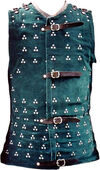| [ studded leather armor | |
|---|---|
| Appearance | studded leather armor |
| Slot | body armor |
| AC | 3 |
| Special | |
| Cost | 15 zm |
| Weight | 200 |
| Material | leather |
Studded leather armor is like leather armor, but one AC point better, providing three instead of two. It also provides MC1. Despite the studs, studded leather armor does not rust, but it does, however, rot. Studded leather does not inhibit spellcasting, so it's a common body armor choice for early wizards.
History
Studded leather appeared in the first edition of AD&D, where it was described as "... is leather armor to which have been fastened metal studding as additional protection, usually including an outer coat of fairly close-set studs [...]"[1]
Studded leather was one of the stock armor types in the original Rogue, where it provided two points of AC reduction[2], rather than three, as in NetHack; this was the same as in D&D.[3]
Studded leather did not exist in Hack121, but has existed as far back PDP-11 Hack, and was included in the Hack 1.0 release.
Generation
Armor comprises 10% of all randomly-generated items in the main dungeon, 0% in containers, 12% on the Rogue level, and 20% in Gehennom. There is a 72 in 964, or ~7.47%, chance that a randomly spawned armor object will be studded leather armor.[4]
Studded leather armor is one of the protective items that can be spawned of certain eligible monsters—including all of the Yendorian army, as well as watchmen and watch captains.[5]
Origin

Reconstruction of 15th century brigandine armor
Studded leather armor does exist in the real world, but not as it's generally thought of from video games such as NetHack. In real life, the studs on leather armor did not add to it's protection in any way, but rather, were strictly ornamental, or in some cases, merely what was holding the layers of leather together.
This is a carry-over from D&D, the inspiration behind many fantasy games, as NetHack, and is seen in many, many games. This misinterpretation is most likely based on seeing medieval artworks of brigandine armor[6]—which has highly visible rivets on the outside layer of leather—but is another type of armor entirely.
Studs, as often seen on fantasy leather armor, would add weight without adding protection, and weight was an omnipresent enemy in medieval warfare, even more-so than in NetHack. Worse, the studs could drive into the wearer of the armor, actually limiting the protection it provides.[7]
- ↑ AD&D1 Dungeon Masters Guide, Page 27
- ↑ http://rogue.rogueforge.net/vade-mecum/
- ↑ http://www.dandwiki.com/wiki/SRD:Studded_Leather_Armor
- ↑ http://www.steelypips.org/nethack/343/armr-343.html
- ↑ http://groups.google.com/group/rec.games.roguelike.nethack/msg/e34120648c374754
- ↑ http://www.mercwars.com/armtype.shtml
- ↑ http://everything2.com/user/Hob/writeups/studded+leather+armor